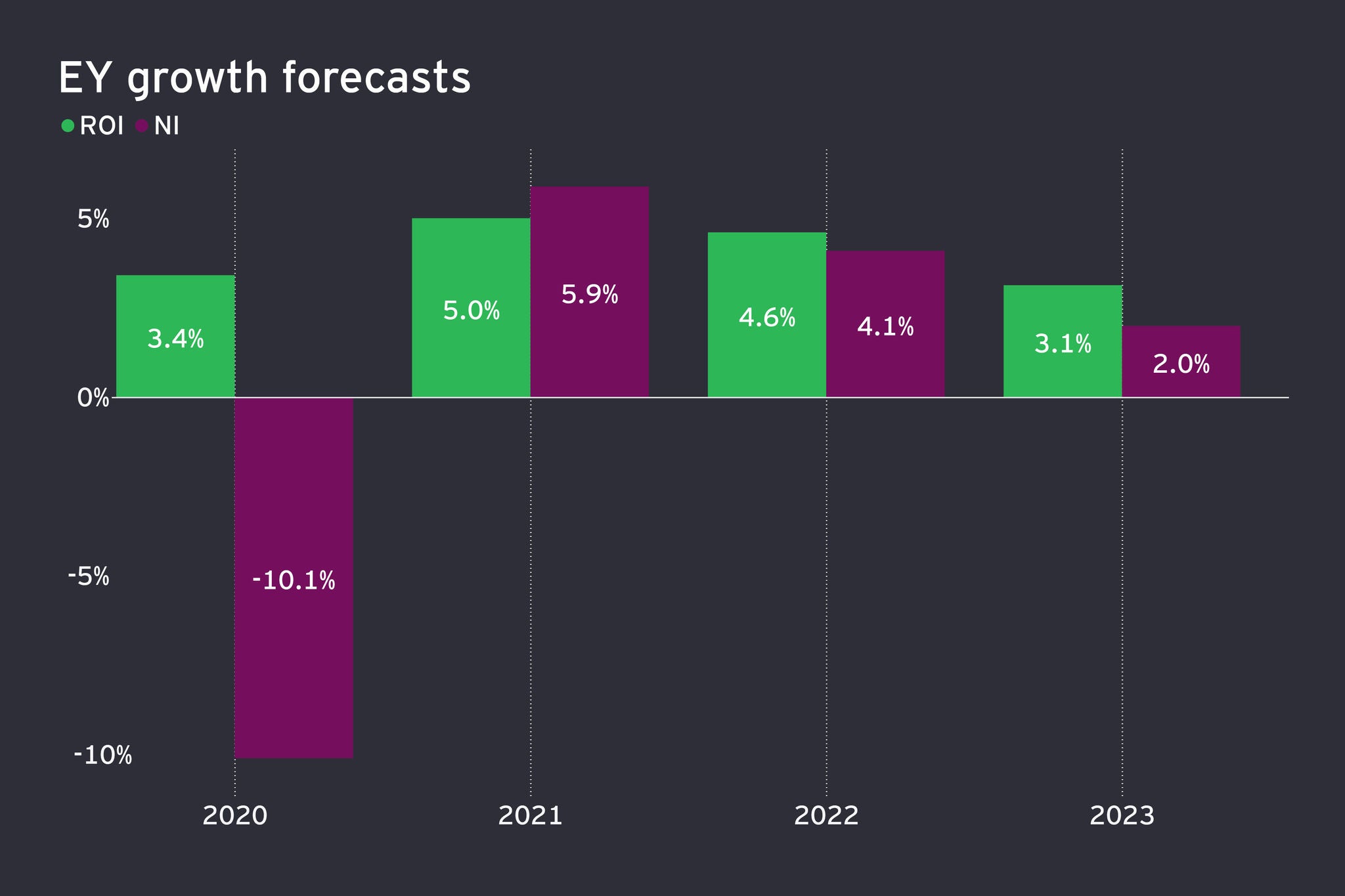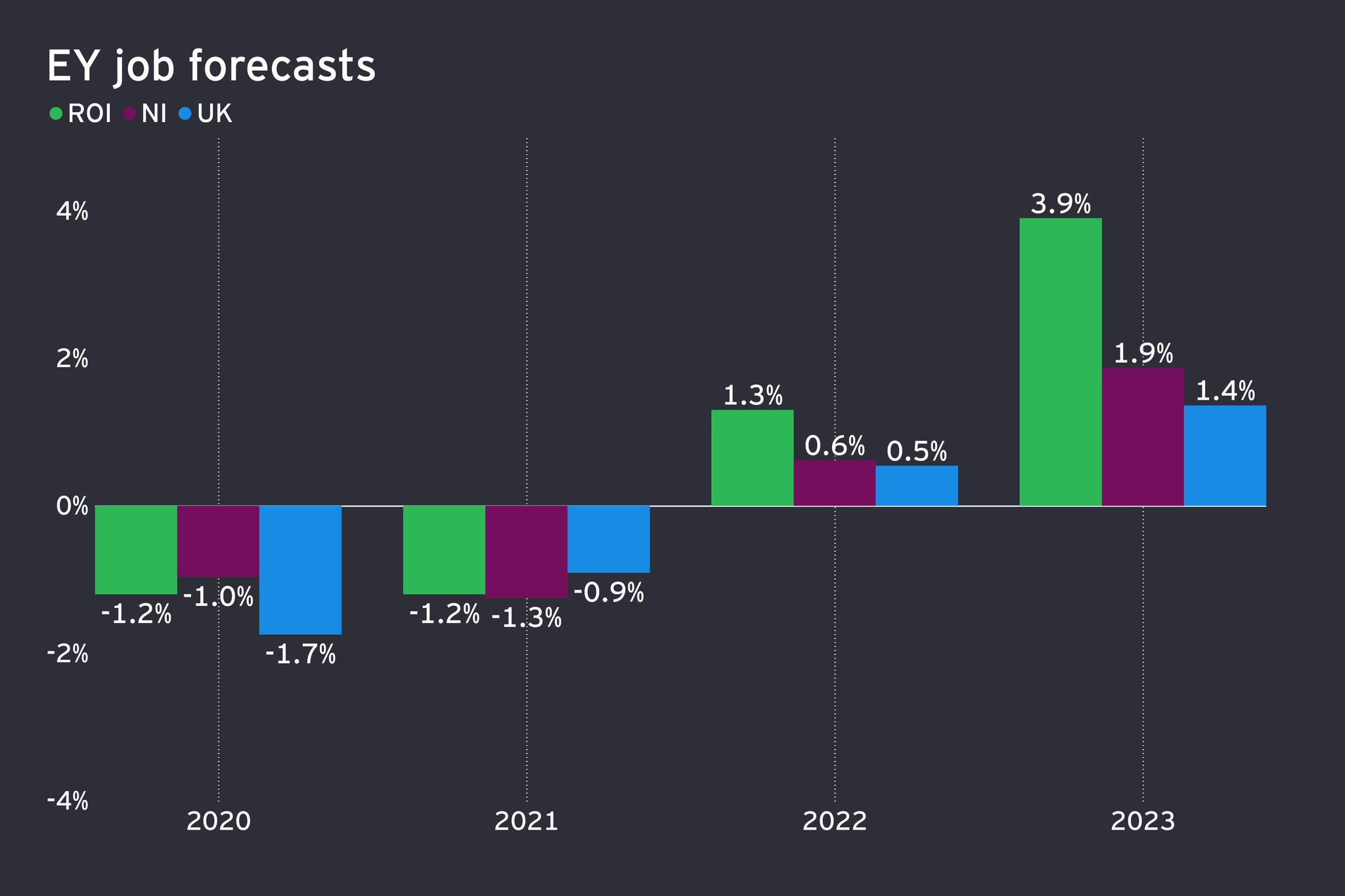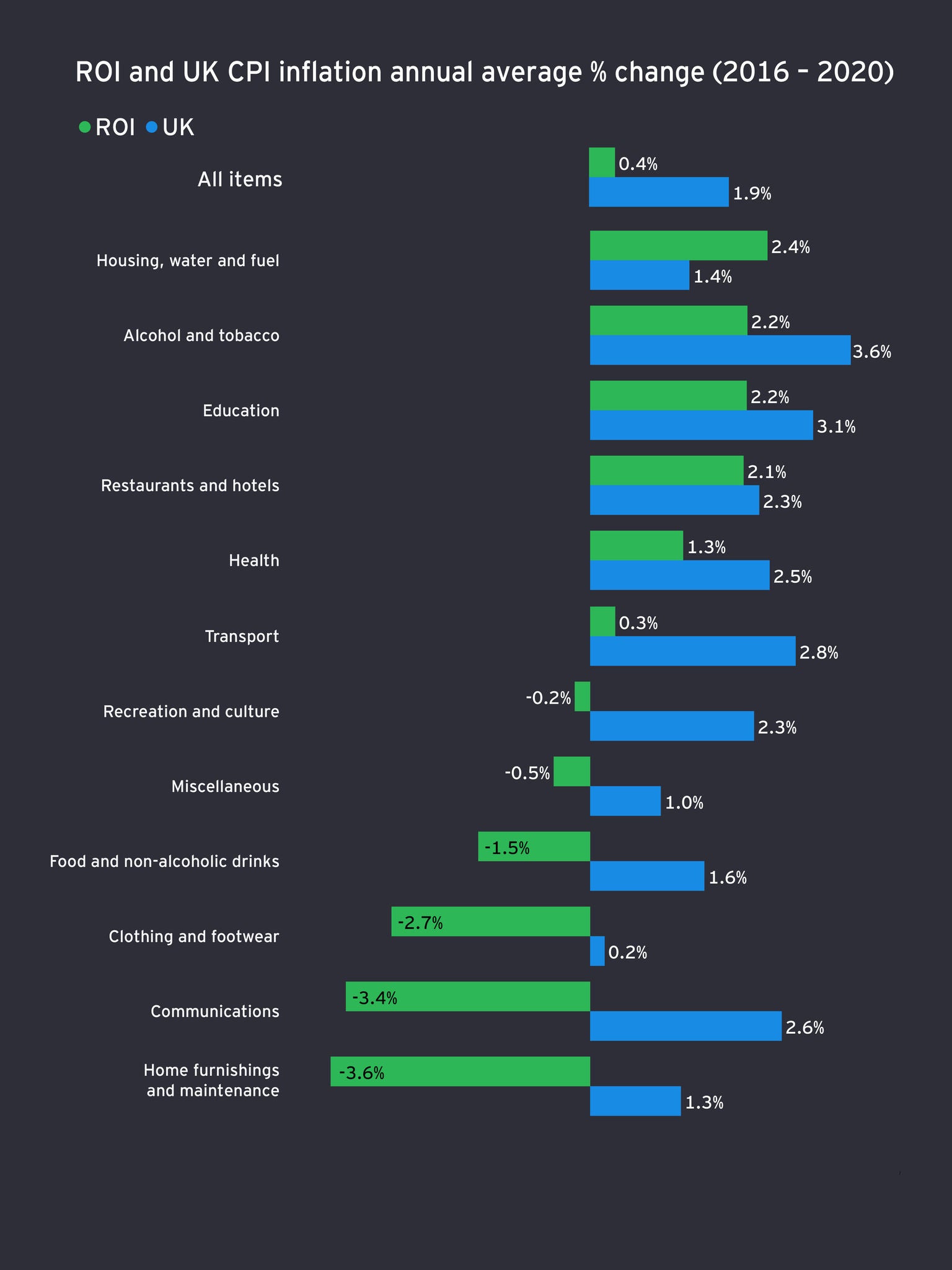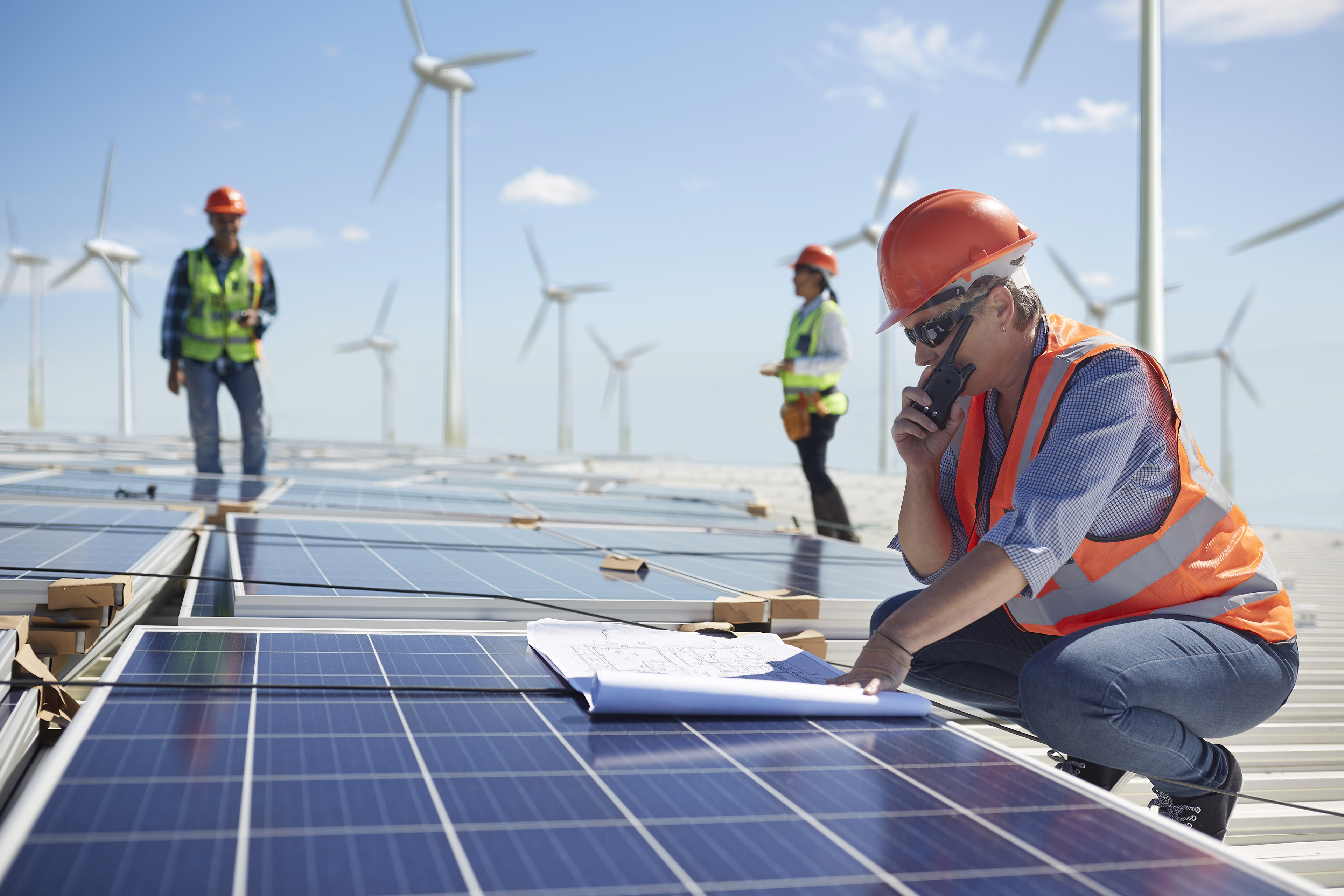EY refers to the global organization, and may refer to one or more, of the member firms of Ernst & Young Global Limited, each of which is a separate legal entity. Ernst & Young Global Limited, a UK company limited by guarantee, does not provide services to clients.

It has been an extraordinary year across the island of Ireland. Covid-19 and Brexit have brought levels of disruption and required policy responses that are unique in peacetime.
In brief
- The headline data appears to tell a story of two economies. Republic of Ireland (ROI) recorded a remarkable 3.4% growth in 2020 compared to an estimated contraction of 10.1% in Northern Ireland (NI).
- ROI’s strong performance reflects the strength of its export base, which is dominated by pharma, ICT and agri-food – all strong performers during the pandemic.
- The sustained period of low price inflation may be over.

Chapter 1
Forecast overview
Amidst all of the economic chaos have been remarkable examples of ingenuity, resilience and adaptability by firms, individuals and policymakers alike. This has been a demonstration of what can be achieved when the stakes are high enough.
The headline data appears to tell a story of two economies. ROI recorded a remarkable 3.4% growth in 2020 compared to an estimated contraction of 10.1% in Northern Ireland (NI), placing the two economies at either end of the global growth league table. ROI’s strong performance reflects the strength of its export base, which is dominated by pharma, ICT and agri-food – all strong performers during the pandemic. Overall ROI tax receipts were down just 3.6% in 2020 and official unemployment rates did not reach the heights feared by forecasters, peaking at 7.1% in 2020 Q3.

Source: EY Economic Eye
As we look with hope to a reopening economy across the island, the second half of 2021 should bring a domestic economic surge. The response by public services, businesses and individuals has been truly inspiring over the last year, but there will be damage, not all of which will be repaired quickly.

Chapter 2
Economic Outlook – Global Outlook
2022 outlooks are somewhat stronger than previously projected. The strong performance of stock and property markets across the world’s major economies indicates a surprising level of global optimism, given the scale of economic contraction experienced in 2020.
This reflects partly the level of government intervention in most economies, along with a growing belief in the vaccine programme. The GDP growth of the ROI and Chinese economies stands out in 2020, with Spain being the only major economy worldwide to have contracted by more than 10% - a better outturn than most forecasters predicted six months ago.
GDP forecasts, key markets
|
2020 |
2021 |
2022 |
|
|---|---|---|---|
|
World |
-3.3% |
6.0% |
4.4% |
|
Euro area |
-6.6% |
4.4% |
3.8% |
|
China |
2.3% |
8.4% |
5.6% |
|
Australia |
-2.4% |
4.5% |
2.8% |
|
US |
-3.5% |
6.4% |
3.5% |
|
Brazil |
-4.1% |
3.7% |
2.6% |
|
Japan |
-4.8% |
3.3% |
2.5% |
|
Germany |
-4.9% |
3.6% |
3.4% |
|
Canada |
-5.4% |
5.0% |
4.7% |
|
India |
-8.0% |
12.5% |
6.9% |
|
France |
-8.2% |
5.8% |
4.2% |
|
Italy |
-8.9% |
4.2% |
3.6% |
|
Spain |
-11.0% |
6.4% |
4.7% |
Source: IMF World Economic Outlook, Real GDP growth, April 2021

Chapter 3
Macro Outlook
Headline growth in ROI beat market expectations with a 3.4% outturn in 2020, confounding fears of double-digit contraction that existed a year ago.
This strong performance reflects the structure of the ROI economy, along with measurement quirks, and allows the country to claim the title as the world’s fastest growing economy in 2020.
The overall forecast for NI is for a very similar level of contraction in 2020 to the UK, at-10.1%, as both are heavily dependent on consumer spending for their overall growth. A more modest recovery is projected for 2021 and 2022 and reflects the sectoral limitations of the region.

Source: EY Economic Eye, UK ITEM Club
There are a number of opportunities arising in the post-Brexit environment for existing NI businesses and new investors alike. The unique position of the region with respect to market access and certification creates a relative advantage compared to other GB locations. This uniqueness will help the region to be shortlisted by prospective investors, at which point NI’s other advantages relating to skills, quality of life and cost can come into play. To realise these opportunit

Chapter 4
Labour Market Outlook
Employment and unemployment figures are now heavily distorted by the impact of various government support schemes, and are only mildly informative. In Q4 2020 NI recorded the lowest rate at 3.6%, followed by the UK at 5.1% and ROI at 5.7%
The level of government support has been remarkable, with roughly three out of ten of the working age population across the island estimated to be working in a sector outside of public administration, health or education and not receiving any pandemic-related support as at January 2021.

Source: EY Economic Eye, UK ITEM Club

Source: EY Economic Eye.

Chapter 5
Brexit
Many businesses let out a sigh of relief at the end of 2020 as a no-deal situation was avoided, but that was far from the end of the Brexit journey.
The full impact of Brexit will begin to emerge over the course of 2021, we will be looking for developments in the following key areas;
- Political
- Services
- Financial Services
- Opportunities
The UK may have left the EU, but Brexit isn’t over, with ongoing impacts on service companies and those trading certain goods. The next 12 months will see further changes, including for UK financial services firms.

Chapter 6
Could the low price era be nearing its end?
Both economies have experienced a sharp rise in their national debt. In ROI, the government deficit for 2020 is estimated at €18.4bn, while the UK figure is estimated at £256bn. Both are projected to rise further in the first half of 2021.
Could prices begin to rise more sharply? Are we potentially complacent after years of non-existent inflation?

Source: EY Economic Eye

Source: CSO, ONS

Chapter 7
Implications for business
There is a widespread feeling of optimism for the second half of 2021. Reopening the domestic economy and a surge of pent up demand should lead to a feel-good phase for the economy and businesses.
Tougher policy decisions lie ahead but, barring a significant health setback, a very strong growth phase is on the horizon. This will not be the case for all, however, with the end of government supports and the impacts of structural changes in a number of sectors leading to increased unemployment.

Chapter 8
Key takeways
6 key takeaways
1. Two economies at either end of the growth charts in 2020
ROI was the fastest growing economy in the world last year, despite its domestic contraction, while NI was one of the weakest. This pattern of divergence is not shared across all economic indicators.
2. Similar labour market disruption
Labour market disruption was more severe in ROI based on official data. However, NI will take longer to recover to peak employment levels.
3. A spending surge is coming
There has been a sharp increase in savings built up across the island. How and when these will be spent will factor into the recovery for many businesses which have been effectively closed for a prolonged period.
4. The sustained period of low-price inflation may be over
There are a number of factors that could drive up inflation from its historically low levels.
5. Tough times ahead for policymakers
Deciding on the timing of reopening and the reduction or removal of pandemic-related supports presents a significant political challenge.
6. A new era of investment is on the horizon
Firms and governments increasingly want multi-location strategies and public investment is set to remain high. The island of Ireland is well placed to benefit from both of these trends.
Summary
In summary, the economy is set for rapid growth in the second half of the year, the labour market is likely to take longer to recover losses, policy is focused on fast growth, but tough choices ahead, conditions are primed for an increase in prices across the island as we move into a new era of investment.
Related articles
Economic Eye Report Winter 2020 - Bouncing back or stepping forward
Uncertain trends in health policy and a complex political environment across the globe have made this the most challenging all-island Economic Eye forecast to produce.



